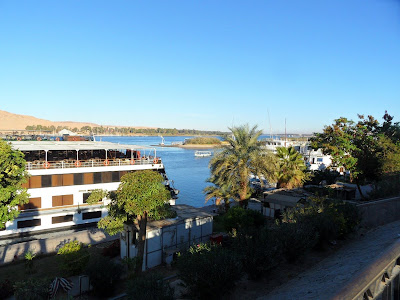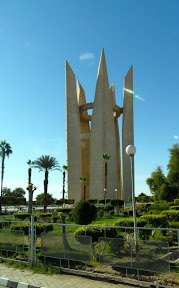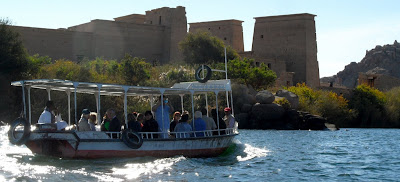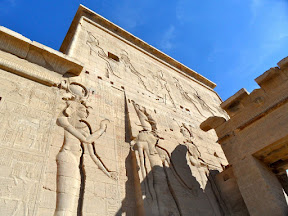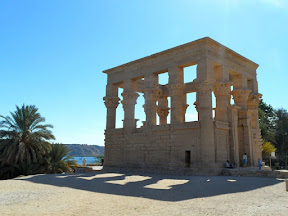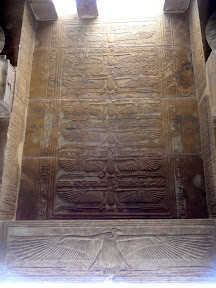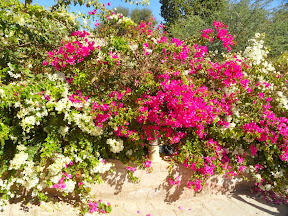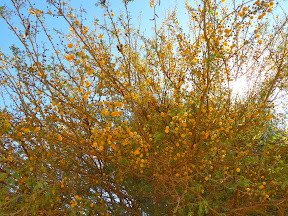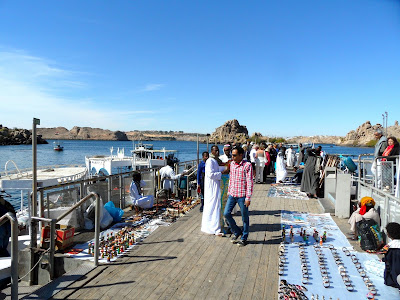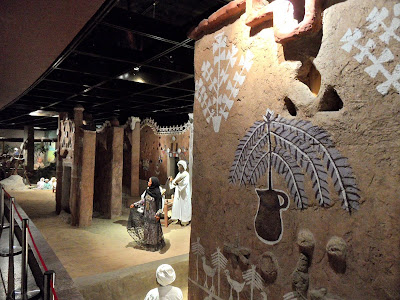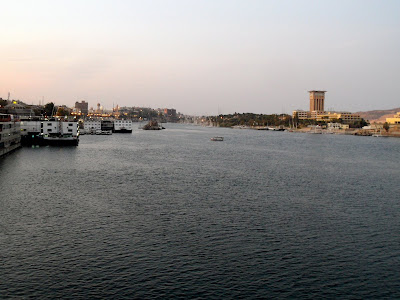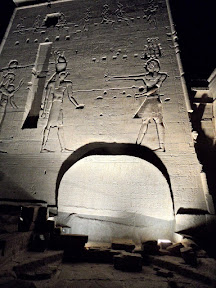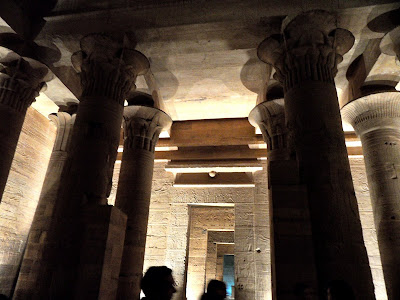Day 4: Aswan and Abu Simbel, Night Cruise to Philae TempleThe next morning we had arrived in
Aswan and the ship had docked in it's usual manner - stacked up against several others, which together made a fiddly but luxurious gangway to solid ground. Our first sight? A lovely
dredging rig taking away unwanted yuk from the dockside. It could only get better.
Aswan was the city at the end of the navigable part of the Nile, being as it were at the site of one of two large dams. The
Aswan Low Dam was built by us Brits in the early 1900s, located at the south end of the city outskirts. The
Aswan High Dam - built fifty years later after the
Egyptian Revolution - we would be coming to later, but it's effects we would see today.
Today was the first day of the 'optional tours' - extra excursions we had the option of signing up for, at extra cost. Most hyped of all the tours occurred today - the great temple at Abu Simbel. It was quite far away and we had two options if we wanted to go see it; get up at 3am and bus it there, or at still more expense, get up at a far more reasonable 8am, drive to the airport and take a plane there.
What the hell, we thought, pay for the flights.
So after a quick breakfast we were off in a coach with Hani once more. The steps up to the main road were more direct and so we had less time to be bothered by vendors. The road took us down the busy Aswan streets; a long straight promenade route passing several semi-empty ferry terminals and the occasional unloved tourist shop - including a shorefront McDonalds that looked quite modern - except that it was burned out and quite abandoned, from what we only hoped was a kitchen fire and not something more deliberate.
 |
Sights came and went. A beautiful Coptic Cathedral marked the edge of the tourist area, beyond which the buildings became scrappier and more like the dusty, run-down places we had observed on our tour around Luxor. The average-income Egyptian houses have a semi-demolished look to them, almost by design. The climate is almost rain-free so many do not have roofs, and still others lack plastering or other such niceties on the external walls to hide the ugly brickwork inside. The parched land means that earth is dusty and liable to collect in dunes around the base of structures giving them a dirty and unkempt look. Many do not have windows, as through most months the heat requires them to be almost permanently open anyway. Unless you have the cash for air con, which many do not. Finally, several had an appearance of being only partially built, as the upper floors often had the beginnings of a floor above them - concrete pillars with steel reinforcements poking out the top for example - presumably to allow the occupants to cheaply increase their living space as their family needs grew. It is easy for a westerner therefore to mistake perfectly occupied buildings for empty wrecks, a mistake we were trying to get out of the habit of making.
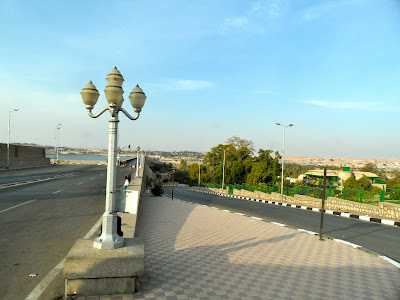 |
 |
We passed on the road along the length of the lower dam, which now had mostly been made redundant by the high dam further up and out of sight. The lake it held back looked peaceful with sailboats and barges coming to life to await the trickle of tourists. The other side of the dam was expectedly lower and consisted of a number of pieces of old machinery - what appeared to be an old hydro-electric unit to take what remained of the water flow and convert into electricity for the city - half buried in undergrowth.
The sight of a few soldiers stationed on the outskirts, complete with tank in case things kicked off told us that there was still a certain amount of unrest in the area, and after a checkpoint, where all on board tried their best to look as relaxed and non-terroristy as possible, we managed to get into the airport without incident.
Aswan airport had the usual set of baggage scanners on the entrance, but the security was on the whole less strict than we get in the UK - which felt a bit weird - was it them being too lax or us too paranoid? - but nevertheless we were soon all through and into the waiting area for our plane, which was running about a half hour late.
I spent the time leafing through several English language books at a tourist shop - some I had seen elsewhere and others seemed exclusive to the shop, but all were in better nick than what the vendors were passing round, so after a little umm-ing and ahh-ing with the missus I got what seemed to be the most comprehensive for a decent price.
Lesson 3: If you are thinking of picking up some drinks or snacks at an airport shop - or any shop for that matter, you'll notice that the price isn't on anything. That's because you'll get charged anything the assistant wants because you're a tourist and you probably won't be able to work out on the hop when you're getting scammed. If you pick up a few items and the guy informs you that it just happens to work out at a nice round figure - particularly if that figure is a denomination of currency -
you're being screwed.
Either put the items down on the desk and leave (which may prompt a better price), or work out roughly what you think it will cost beforehand, and then be prepared to barter him down.
We stood in a queue for the coach ride to the plane for a while with our overpriced drinks before realizing the security would probably not allow us to take it. I glugged mine down in desperation, while my calmer girlfriend relied on her charms to get hers through, which worked admirably.
The plane ride passed without incident and we arrived about a half hour afterwards at Abu Simbel airport, a little strip which seemed to exist mostly for the tourist trade from Aswan and Cairo. The departures lounge was a single room with open doors either side, decorated for Christmas with a bit of tinsel here and there, and strangely, a large saxaphone-playing Santa Claus.
Our coach ride through the desert later brought us to a small, quiet suburb, which seemed to have grown up around the main attraction. The coach parked up strategically, meaning we would have to pass through a sweeping curve of tourist shops, manned by a dozen or so vendors waiting at the ready to pester us as we ran the gauntlet to the temple.
Unlike the other attractions up to this point, the temple at Abu Simbel does not show itself off to it's admirers immediately. On escaping the curved bazaar and resisting the urge to use the manned (and therefore pay-to-use) toilets, you approach by way of a gravel path barely distinguishable from the ground beyond, a large mound of crumbling rock, sat looking out on the shores of
Lake Nasser. As you round the rockpile, you need to take care not to rubberneck the emerging view too much lest you take your eye off where you are going and fall on your face over an unhelpful rock. Hani, clearly not wanting to waste time after a late flight, hurried us round and the massive Abu Simbel temples finally showed themselves.
The main temple is embedded in the large rock face. Four giant statues of King Ramesses II, each the height of a 6-storey building sit either side of the main temple. The temple of Hathor and Neferati sits adjacent, which on it's own, with the six massive statues guarding it's own entrance would have looked pretty impressive, if not for Remesses' need for one-upmanship.
The main temple, the lake and the dam are all linked together in a
fantastic example of archaeological preservation. Had we come a hundred years previous, the temple would not have been there, it would be in the spot where it was originally built - now well underwater. When the Aswan High Dam was built in the fifties, the level of the water upstream naturally began to rise, which was bad news for Abu Simbel. In the mid-sixties, the temple which was by then partially submerged by water was cut up into huge blocks and transported further up the hill, where they were very carefully re-assembled as accurately as possible - right down to the position of the stones of the fallen statue, and the angle of the temple with respect to the suns' rays - necessary to preserve the intended illumination of the innermost statues within on two days per year.
 | 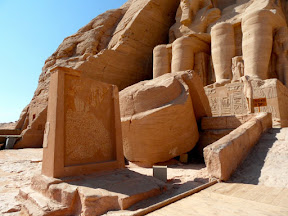 |
Hani talked for a little while outside on these things and more, and then we were given chance to head inside the temples. Annoyingly, we were barred once again from taking pictures inside. The temples were pleasantly cool inside. It was possible to see the water line markings a foot or so up from the floor, showing just how late they left the move. A moodily lit entrance hall, complete with ceiling-high statues led to the innermost chamber, where the four human-sized statues, carved out of the rock behind, sat. Unlike the relatively peaceful murals at Kom Ombo, the inner carvings at Abu Simbel were much more of a show of force, with carvings of neck- and elbow-bound Nubian prisoners cowering under the might of the great Ramesses, who was often shown in a fighting stance, a sword in his right hand, held aloft about to do some pretty hefty damage to an unfortunate who happened to be born to the wrong race.
We briefly had time to look inside the small temple, whose contents were much less violent. Square stone pillars topped with carvings of Hathor's face looked out at you with a benign, Mona Lisa-type smile, and the sunken carvings adorning the walls were generally of Gods giving and receiving presents, or acting out stories of old, rather than about to lay the smack down on the non-conformists, although Ramesses did manage to crowbar that into the odd spare space.
We joined the trail round the back of the temples, and followed a less-walked path to complete the circle of the area, arriving back where we started. We were picked up by a particularly persistent vendor on the way thanks to a misplaced glance towards some trinket or other, who followed us with protestations we were ignoring him interspersed with a gradually decreasing asking price for whatever he could carry with him on the journey back to the coach. By the time we had got back, the poor man was pleading for a tenth of the original asking price, but we were never interested in the first place. Hani did his trick of making a one-time offer to provide some exclusive photo prints of the inside of the temples for anyone who wanted them, and giving them out to those who stuck their hands up for a nice bit of extra folding in his pocket. We didn't bite.
The plane ride home was uneventful and we arrived back at our room to find the newest of our towel sculptures - a 'Happy New Year' sign made from loo paper, which was.. nice. We had a little bit of time to have a rest and some dinner, during which we reviewed what we saw against how much we had paid for it, and came to the conclusion that, if given the opportunity over, it really wasn't worth the trek. Meeting up with some of the others in the lobby, we prepared for our second optional tour - a night time light and sound show at the once-submerged Philae temple.
The upper dam was to Abu Simbel what the lower dam was to Philae. When the dam was built - and subsequently shored up in height twice - the waters slowly began to engulf the temple in it's original location of Philae Island. In the sixties, at around the same time that Abu Simbel was being moved, archaeologists erected a temporary dam around the site - which by then had been almost completely submerged - and painstakingly moved the numerous structures out of the water and up onto the nearby hill - now island - of Agilkia.
We were told to grab our life jackets from under our beds and bring them with us -
important health and safety concerns they said. A dozen or so of us squeezed into a couple of well-used minibuses and retraced our steps up past the low dam, to the port at the edge of the lake.
Once we had our tickets and were through the barrier gates, we walked down a cobbled road to the shore where a handful of floodlit tourist boats were waiting with a smattering of skippers. We were all squeezed into one of them and after a little fiddling with the engine, we were off.
Once going, Hani took off his life jacket and said we could all do the same, so we did - so much for health and safety - but it was getting a bit parky so we cuddled them for warmth on our laps. The lake cooled the air as it passed over us and after five minutes of near total-darkness we began to see the lights of Philae temple as we rounded the point.
The invisible hands behind the show were just getting things ready so we milled around for a little while in the grounds. There was a roped off area that cordoned off the inner parts of the temple complex, so we guessed the show would just be from the perimeter looking in. Still, that allowed us a good look at the impressive structures rising moodily from the earth.
The show started; a male voice boomed out from the structure. The god Osiris recounts the thousands of years of history of his burial place. He converses with an equally formless female voice representing his love, Isis. As they talked, the darkened corners of buildings and previously unseen carvings were highlighted to accompany the stories they told. After a short while, a man came and took the rope away and beckoned us to walk up the entrance pathway and into the temple, as intermission music played eerily in the background.
Working through the temple we ended up in an open area with lines of benches, where we all sat for the final part. By now we had grown accustomed to any cheesiness in the vocals and listened as Isis lamented the thousands of years of neglect, and Osiris tried to cheer her up by paying tribute to the work done to preserve the temples for the future.
After a rousing orchestral score died down, and the place went dark once more, we sat and enjoyed the silhouetted outline of the temple against the stars, and then ambled back to the boat. We passed the beautiful Coptic cathedral again; this time surrounded by churchgoers waiting for the new years festival to start, and again my camera was unable to take a decent picture in the dark. I sulked.
To greet us on our return to the boat was the New Years Eve dinner. What we had been given to this point had been good stuff and plentiful, but the chefs had gone all out on us. As we entered the dining room our first sight was a huge display of streamers, balloons, fancy sculptures and come
professionally carved gourds, each with a light stuffed inside them so they glowed and projected their patterns on the ceiling. The buffet was obviously off, this was an eight-course super-dinner.
We staggered from our chairs but it wasn't over. We had to wheeze from the bottom deck to the top, where our hosts had put on some traditional Egyptian entertainment.
It started simple enough, a couple of guys with drums and a sitar-style instrument. And then came the horse.
Two men in horse guise, jumping about madly and encouraging any volunteer they could to get up and perform with them. We clapped and cheered, and hoped we wouldn't be chosen, which the missus almost did when it came over and (quite painfully) tried to french kiss her.
But top marks for embarrassment came with the crazy dancing guy. He had a grass skirt and an insane glare. He went round the room and grabbed any volunteers he could - including both of us. Being the tallest, I was put on one end of a half-women, half-men line, and typically, after we were all made to dance and shout as a group, I was chosen to do some shouting of my own.
I had to follow what the crazy guy said and did while people clapped and laughed. Especially the missus, who relieved that he had decided to pick on just me, eyed me with the relieved/amused look of a schoolkid who realised she had just got away without having to read in class.
I did my shouting and waving my hands in the air, and was glad when the others were re-involved once more to spread the embarrassment around a bit. No. There are no pictures.
Feeling that we had done enough for one evening to embarrass ourselves in front of strangers, we took back to the cool air of the streets again. It was about 10pm, and the city was beginning to come alive with the new years' celebrations. We began walking along the promenade, but as you would expect we were soon approached by people trying to sell us things. At night, this is usually what we had: a couple of guys with a horse and carriage. We had been told about the vendors with the carriages on the ship, that they mistreat their horses and can't always be trusted to take you where you want to go. The horse looked a bit on the thin side, a true beast of burden, but they followed us as we walked along, and wouldn't take no for an answer. Eventually, we relented as our walk was going to be all about repeatedly shouting 'no!' at them, and on condition of them giving the horse some food, we jumped on the back and proceeded down the prom.
 |
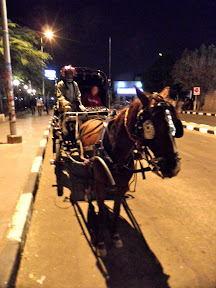 |
Initially we were unsure where we would go as it was just meant to be an aimless stroll to walk the food off, so we settled on going to the cathedral, which was about ten minutes away. We winced as the whip came down on the poor horse to get through the traffic, which was a bit of a hairy experience in itself, and we pleaded with them that a canter was just fine to get us there; we were in no hurry.
The streets were alive with young men, and some women, in westernised clothing, while others walked along in more traditional dress. Everyone seemed to be in good spirits, hoping I'm sure that 2012 would be the start of a succession of progressive years for the country.
We made it to the cathedral, but hopes of getting inside were dashed; the doors were closed and a large queue of people were snaked around the block waiting to enter. We made do with a few pictures of the outside as I darted in between the randomly moving cars.
We looped around and headed back; it wasn't the most enthralling journey but we got to see the teeming city by night without a pane of glass between us, and were glad just for a bit of fresh air as well. We stopped and paid our chauffeurs a little early and headed down to the docks. At a few minutes to twelve, I descended the rickety stone steps and dunked my shoe in the Nile water, so I could make the 'in de Nile' joke which I find endlessly amusing, and then, as the clocks struck midnight, we shared a romantic kiss in a quiet part of the dockside to welcome in 2012.
And we got a
monkey in our room.
